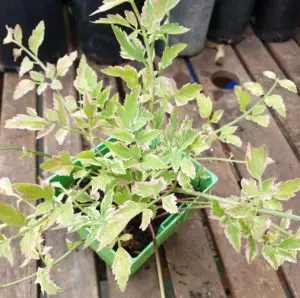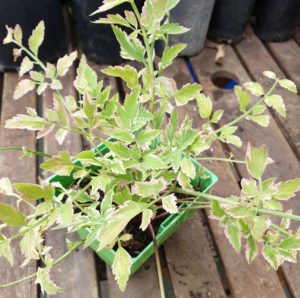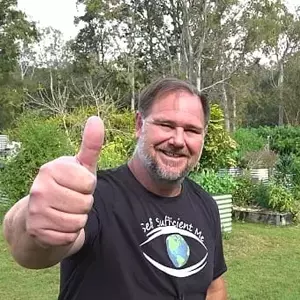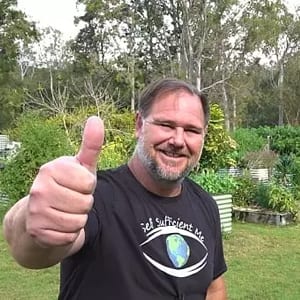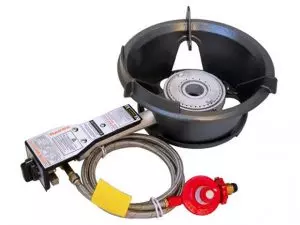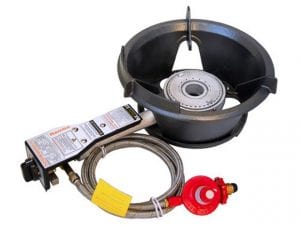Not all of us get through life unscathed, and the chances are most of us at some point in time will need to recover from a serious injury or operation due to some unforeseen event, injury or illness. Rehabilitation and recovery from a traumatic physical injury or illness is a steep mountain to climb and can be an extremely scary experience even for the strongest of individuals.
Parachuting accident
In May 2000, I was involved in a serious parachuting accident. Basically, I was participating as part of a military training exercise in central NSW, Australia where I was jumping out of a Hercules aircraft when a series of unfortunate events lead to my uncontrolled exit from the plane.
The soldier in front of me balked at the door when we were given the green light to go and I was forced onto my tippy toes pushed up behind him by the eight guys behind me all in full battle kit with weapons.
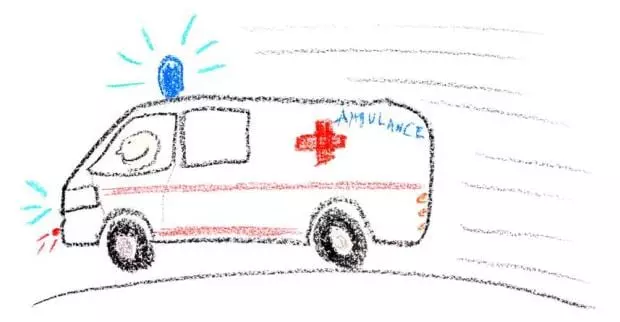
I lost my momentum and as I tumbled out of the door my wrist became entangled in my static line (the line which is attached to the aircraft and automatically opens the chute when you jump).
The slipstream when you first exit an aircraft forces the jumper out like a cigarette butt flicked out of a fast moving car and the tangling of my wrist in the static line meant my arm was still attached to the plane.
This force caused my arm to be jolted back and spiral fractured (twisted and breaking like a honeycomb chocolate crumble bar would). Also, the top of my chest (pectoral) was torn from my shoulder by the backlash force of my arm being whipped backwards. Within a split-second, I was clear of the plane and all was quiet as I began my descent.
It all happened so fast, but the most vivid memory I have straight after my initial exit from the plane was a feeling of dread and numbness coming over me. I began to go through my parachuting drills (at about 900 feet from the ground) and realised my right arm wouldn’t work then I saw blood spurting through my ripped shirt and felt incredible pain on the right side of my body.
I was briefly distracted by another parachutist who was yelling at me to pull-away! as I drifted towards him, but I couldn’t quite gather my thoughts at that moment – luckily for us both, we didn’t collide.
In about the first 90 seconds, I had no idea what had happened to me and why I was injured. I just knew I had been severely hurt and I grappled with the confusion of what I needed to do, or what could I do next… I was paralysed by injury, fear, and indecision.
Then, my mind strengthened and I went into survival mode as the reality hit me I might not live through this jump; nevertheless, I became determined to try and steer my chute as best as I could with my left arm and try to land as safely as possible.
I was losing blood and becoming weak from exertion and extreme pain so I struggled to concentrate as the ground became closer. At one point I considered dropping my pack and equipment which was situated between my legs as landing like this would surely break them both and without the extra weight my landing would be softer. However, I was scared I may miscalculate and drop it through someone else's parachute below me so I fumbled with my toggle rope and finally managed to dangle my pack below me a few metres before I hit the ground.
I landed on the airstrip on probably the hardest bit of ground within 500 metres and it wasn’t long before one of my colleagues who landed nearby noticed I was in big trouble and ran over to help me. He cradled my head and I could see in his eyes that he was very concerned with what he saw… things began to blur for me from that point, although, I do remember feeling relieved I had made it to the ground still alive.
Ambulance break down
I also remember how much pain I was still enduring and how the first medic to arrive just kneeled down next to me and stared. Then, another medic arrived and gave me one of those pethidine whistles to suck on, which seemed to give no relief at all. People were grouped around me and my boot heels sliding back and forth were grinding the hard earth into dust as I tried to manage my pain; then, the medic told me to look over my shoulder as he pointed out an ambulance entering the airfield.
The ambulance was shimmering in the distance through the heat and my watery eyes but it soon became apparent it wasn’t getting any closer. That’s because the ambulance had broken down in the middle of the airstrip (done a clutch cable, I found out later) so another ambulance was called.
By the time the second ambulance arrived to take me to hospital, I had been administered morphine and was really dropping in and out of consciousness. The ambulance took me to the nearest hospital which was an hour away and I awoke to some doctor claiming I was too serious for a regional hospital and I needed to be taken to a major centre, Wagga Wagga, another hour away. I turned to the ambulance officer riding by my side as they closed the doors and started driving away and said “I don’t want to lose my arm, please, I don’t want to lose my arm…” That was the last thing I remembered from that day.
Orthopedic surgery and stabilisation
When I awoke the next morning, I was in a hospital gown with my army boots and clothes at the end of my bed. My arm was bandaged up and I still had no clue about what had happened. I remembered the accident and my arm was still there but I couldn’t move my fingers and something didn’t feel right.
It turns out, due to the length of time it took to get me to surgery and my right forearm being so badly damaged by the bones fracturing and mincing the muscles, the forearm had to be debrided/amputated. Therefore, the bones had been pinned and reset with plates but the gaping wound was still open. The orthopedic surgeon in Wagga Wagga did an incredible job in piecing the bones in my forearm back together as they had been fractured in numerous places. He then referred me to one of his friends in Sydney to complete my operation.
Muscle transfer surgery to save arm
I then had to make the journey to Sydney that day to be placed under the care of one of the world’s top hand and arm surgeons (Dr James Mason) who ironically was serving in the Reserves as part of the Army Surgical Parachuting Team. The army decided to transport me to the Sydney hospital via car – this was a 5 hour road trip. Thankfully, I slept most of the way and my wife (Nina) and mother (Coral) had arrived from interstate to help me also.
As soon as I arrived at the Sydney hospital, my Doctor advised me the only possible way to save my arm was to have what’s called a “muscle transfer.” This is when a muscle is taken from one part of the body and transplanted to another part. In my case, it was decided my whole left latissimus dorsi would be needed as a replacement for my right forearm as it was large enough to fill the space left by the amputated muscles and cover my exposed bones and tendons.

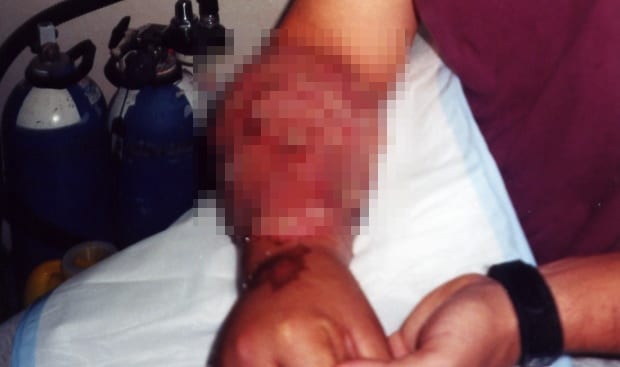
Here is an image (above) of my arm several weeks afer my latissimus muscle transfer to replace my forearm operation
The latissimus is the large muscle under the armpit (your “wings” in muscle building terminology) and it’s a huge muscle and a big operation to remove it. Also, to cover the replacement muscle on my rebuilt forearm, I needed skin and that was “shaved” from my left thigh (the massive white scar on my leg will always be there as a reminder).
So it was done, the next day I awoke again from surgery in so much pain I was dizzy and couldn’t see clearly until I had a pethidine injection administered by a drip which was constantly attached to my arm. Press a button and my pain would go and eyesight clear up for a few hours and then press the button again…
My left back had a million stitches and a gash 40 cms long from under my armpit down to my belly with a drain at the bottom to remove excess bleeding and fluid. My right arm looked like Popeye the Sailor Man’s forearm after he’s eaten spinach! It was bandaged like a mummy and very heavy.
Surgery to fix shoulder and chest
A few days later I needed to have further surgery to reattach my chest back onto my right shoulder – I tried to reason with the surgeon in my delusional state and argued my chest/shoulder felt OK so I probably didn’t need another op. Of course, I was kidding myself and reluctantly agreed to having my shoulder fixed after kind explanations from the doctors and my family. By the end of that operation I was totally fed up with going under the knife and lying in a hospital bed motionless.
Furthermore, I hadn't escaped lower leg injuries from the uncontrolled landing during my jump and had to deal with two badly sprained ankles, a twisted knee, and badly bruised coccyx.
Mother involved in emergancy plane landing
On a side note, my mother was helped by my Aunt (Lynette) an aviation industry icon in Australia to charter a small plane in order to immediately fly from QLD to be by my bedside. During the descent the front wheel failed to come down for landing and my mother (as a passenger) was directed by the pilot to crawl down on the floor of the light plane and release the landing wheel manually by hand as emergency landing drill. Amazingly, my mother managed to release the wheel and they landed ok. What is it with my family and airplanes? Still, I was very relieved by my mother's arrival and thankful for my Aunt's help, charter costs, and risking life and limb to help mum fly down to see me.
The recovery
Anyway, I began my long road back to recovery and a long road it was… The hospital stay was depressing me. The nurses and doctors were great, the accommodation was good, and my wife (girlfriend at the time) was a massively important help emotionally for me, but it was difficult going from being an active fit soldier to a bedridden injured man with a sore arse from laying in bed so long. Time lingers when you’re on your back in a hospital bed – it’s insane!
As soon as I was allowed to get off my bed (initially with help) I began my rehab pacing the hospital corridors for hours like some purposeless ghost pushing my drip trolley stand and quietly shuffling barefooted for as long as I could stand. I intently listened to instructions given to me by the in-hospital head rehabilitation therapist and practiced my coordination exercises to try and get my fingers working properly again. I was released from hospital three weeks later.
My wife who was also a serving member in the Army was made to return to work in Brisbane, so my sister (Ines) flew from South Africa (where she was living at the time) to continue helping me with my recovery – she’s a nurse and I forgot to mention my wife’s a nurse also so I was very lucky to have close family around me who not only cared but were medically competent to look after me. I should also mention, my mother filled the gaps between my sister and wife to care for me a bit like a tag team – I will always be eternally grateful to them all.
Staphylococcus infection
So since I had left the civilian Sydney hospital, I was required to have my injuries dressed daily and locally by my military hospital. My sister and I noticed my forearm muscle transplant and skin graft was deteriorating and not healing as expected. The military (civilian) doctor refused to acknowledge this as an issue but Ines insisted I be sent back to my surgeon for a checkup and his opinion.
A visit to Dr Mason was organised, and within seconds of my surgeon inspecting my arm he demanded I be hospitalised immediately! I asked, “how bad is it?” And he said, “Mark, you have a staph infection and you might lose your arm…”
My condition was critical and again there was a serious risk my arm would be amputated. Thankfully, another stint in the Sydney hospital with intravenous drugs and I eventually recovered from the infection and kept my arm.
Rehabilitation and physio
I became obsessed with my recovery and I believe this is what people in my situation need to do if they want to give themselves the the best chance possible of a satisfactory outcome after a traumatic injury/illness. Naturally, I abided by doctors orders but I also pushed the boundaries and followed my rehabilitation exercise routine religiously.
Within 6 weeks I was out jogging (often with my brother as a chaperone) arm in sling, plodding along the footpath all the time determined to get my arm and hand working again. I attended my physio therapy classes and didn’t just do my physio “homework,” no way, I did heaps more than what was supposedly required.
Convalescent leave from my job was about 5 months all up and I didn’t use this time sitting in front of the TV waiting to get better. This was my opportunity to get the proper use of my arm back and I knew it was up to me and me only to ultimately achieve this goal.
When recovering from a serious injury your focus must be on using the injured limb/etc or staying as active as possible (with approval from your doctor). Pain and discomfort will accompany such therapy as your healing body will resist your mind to make it move and exercise, but you must embrace the pain for the benefits in the long term.
Depression
Depression is an enemy to recovery from physical trauma and you must not dwell on what has happened to you but embrace the challenge to prove the great things you can still do with what you have left. If you feel sorry for yourself and dwell on your loss people will still help you; however, you will get more help and encouragement from others if you actively help yourself. If you give up on yourself, you can’t blame others for giving up on you.
Staying active physically will help keep depression at bay (maybe not always, but mostly) when you are down exercise more and focus on your physical recovery. Set realistic short, medium, and long term goals to meet milestones along your road to recovery and these achievements will keep you motivated and interested in getting better.
Goal setting
For me, a short term goal was touching thumb to fingers in my right hand. Medium was lifting and holding objects and my long term goal was to play tennis.
When you reach and achieve these set goals, celebrate and pat yourself on the back – tell friends and family and share your successes with them. At the same time, don’t rest on your laurels because it’s important you continue to work enormously hard on your recovery even if you think you have reached the limit of your gains because I assure you, you have not.
The human body can continue to improve and recover from serious injury for many years after the event. My personal recovery took at least 1 year to get my hand working, 2 years to feel confident enough to throw a ball… sort of, and about 5 years before I was at a point where my body felt somewhat back to normal.
Pain management
Pain management is probably the hardest part of recovery from serious trauma because you may find your pain will never go away – even if your wounds are “fully healed.” Prescription pain medication are of great benefit initially but be very wary of becoming too reliant on pain medication. After your initial recovery, you should try and limit your use of painkillers and if possible totally ween yourself off prescription pain medication altogether.
This may mean, sleepless nights and “bad days” but if you can try and become used to (or tolerate) your pain without the use of heavy medication your body will get better at it and you will be healthier internally for it.
My use of prescription pain medication lasted for about 8 years; these days, I am prescription medication free and proud to be! I do still use the odd over the counter panadol or aspirin to take the edge off a “bad day” but generally exercise and a healthy lifestyle helps me manage pain better than any tablet or injection.
Overuse of prescription or over the counter pain medication will shorten your life and why would you ever want to do that? So, where possible try and go without pain medication or at least use it sparingly for the days when you really need it.
The key to recovery is physio and exercise
I see my rehab and recovery as ongoing (and you should too) because the only way to manage the damage and slow the deterioration of your injury, especially as you age, is to use it and to stay fit and healthy. This point can not be emphasised enough.
In the end, and after all the great surgery my Doctors performed on my body, my main surgeon (Dr Mason) said it was my manic attention to my rehabilitation and my rigorous exercise routine which ultimately saved the use of my right arm. Putting Humpty Dumpty back together again is only one part of the equation the other part is how hard Humpty is willing to work at physio and exercise to heal the body correctly or else he'll always be an omelet (my surgeon didn't say the Humpty bit – I made that up).
And, his point was emphasised by several surgical meetings I attended as a guest for my surgeon to show me to his colleagues as an example of what to do in order to give yourself the best chance of recovering from injury or major surgery. I would explain in these workshops to the physicians the physio and exercise routine I undertook to help facilitate such a successful recovery.
Conclusion
Since the initial operations, I've had several more to remove plates, fix small isues, and plastic surgery to sculpt the arm into a shape making it look more natural.
I continued to serve in the Army until 2008, although it tended to be a battle to continuously make my hierarchy aware/understand the physical limitations I now had so unfortunately for my last few serving years I was treated poorly.
The outcome of the investigation into my accident was never formally given to me, but a friend of mine was a senior medical warrant officer and was privy to the investigations final conference and he told me informally the investigation had concluded a static line wrapping around my wrist on exit from the plane was the likely cause.
There was no mention of the fact that the dispatcher on the day (the guy who grabs the static line and assists the parachutists exit) was a trainee and probably not qualified or supposed to be doing the job at the time. I don’t care, honestly. Nevertheless, my accident was the reason the Australian Army changed the way soldiers exit the aircraft. The procedure is much more structured and is now safer – thanks to me, I guess.
One military hospital administrator once told me, “you know how much you have cost us (the Army)? Nearly, $150,000 to fix you.” I just shrugged, smiled and said, “well, you broke me.”
12 months after my horrific parachuting accident, I had the privilege of being invited back to the Sydney Hospital as the first ex-patient to be the keynote guest speaker at their yearly Foundation Day celebrations. It was an honour to have the opportunity to thank all the staff at the Sydney Hospital for the great work they do in helping people through what is often the worst time of their lives.
As far as compensation goes, my payout for my injuries was minimal much to the disgust of some family and friends who urge me to revisit my compensation claim. However, I don’t want anymore government money – I’m just happy to be alive and to have my arm and health back.
The human body is a wonder of creation – more complex than any other living thing on Earth and guess what? It’s ours… And we’re very lucky to have such a machine to encapsulate our soul enabling us to be who we are.
I now play competitive A grade tennis, and if you follow my blog you’ll see I live a pretty physical lifestyle working in my garden, exercising, making stuff, being a homedad for my two boys, a dedicated husband for my hard working wife, and I'm enjoying life in general. Therefore, my challenge to you if you are reading this and recovering from major surgery, injury, or illness, is to fight on and accept the challenge to physical recovery like a beast possessed and you will endure just like I am.
I hope you found my story interesting, feel free to comment below or to join our forum if you'd like to talk about this story or health and fitness generally in more depth.
Mark Valencia Editor SSM
Respect your body and keep it healthy through regular exercise…

